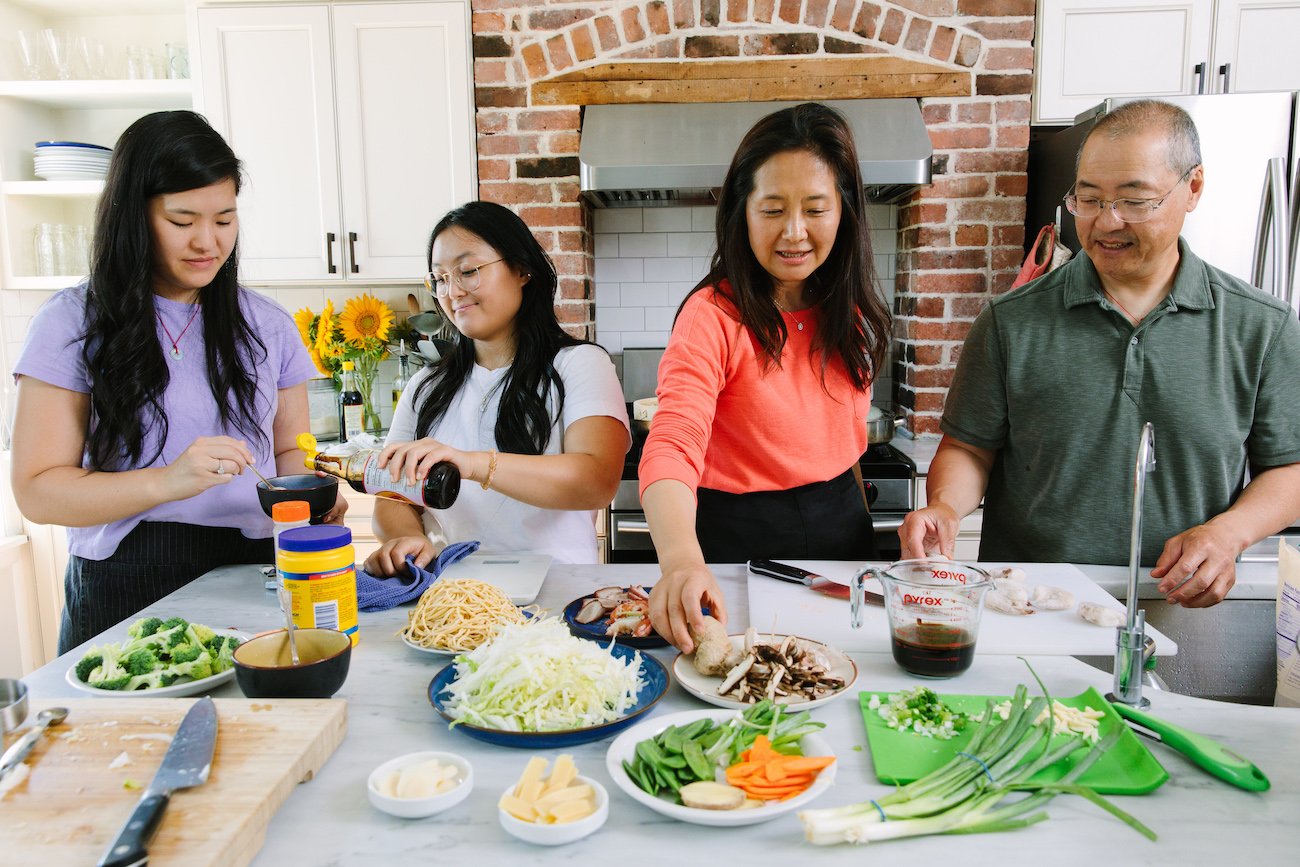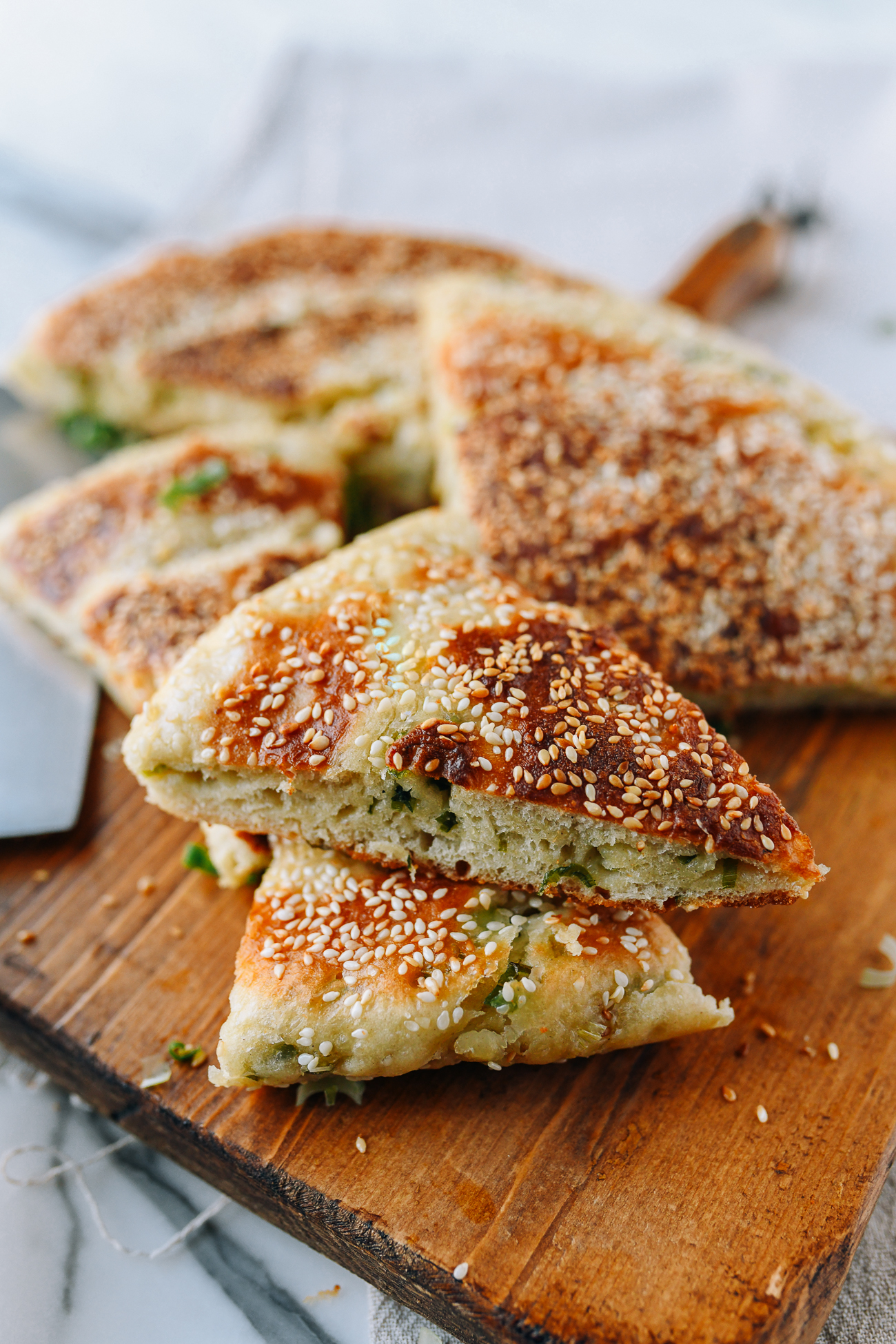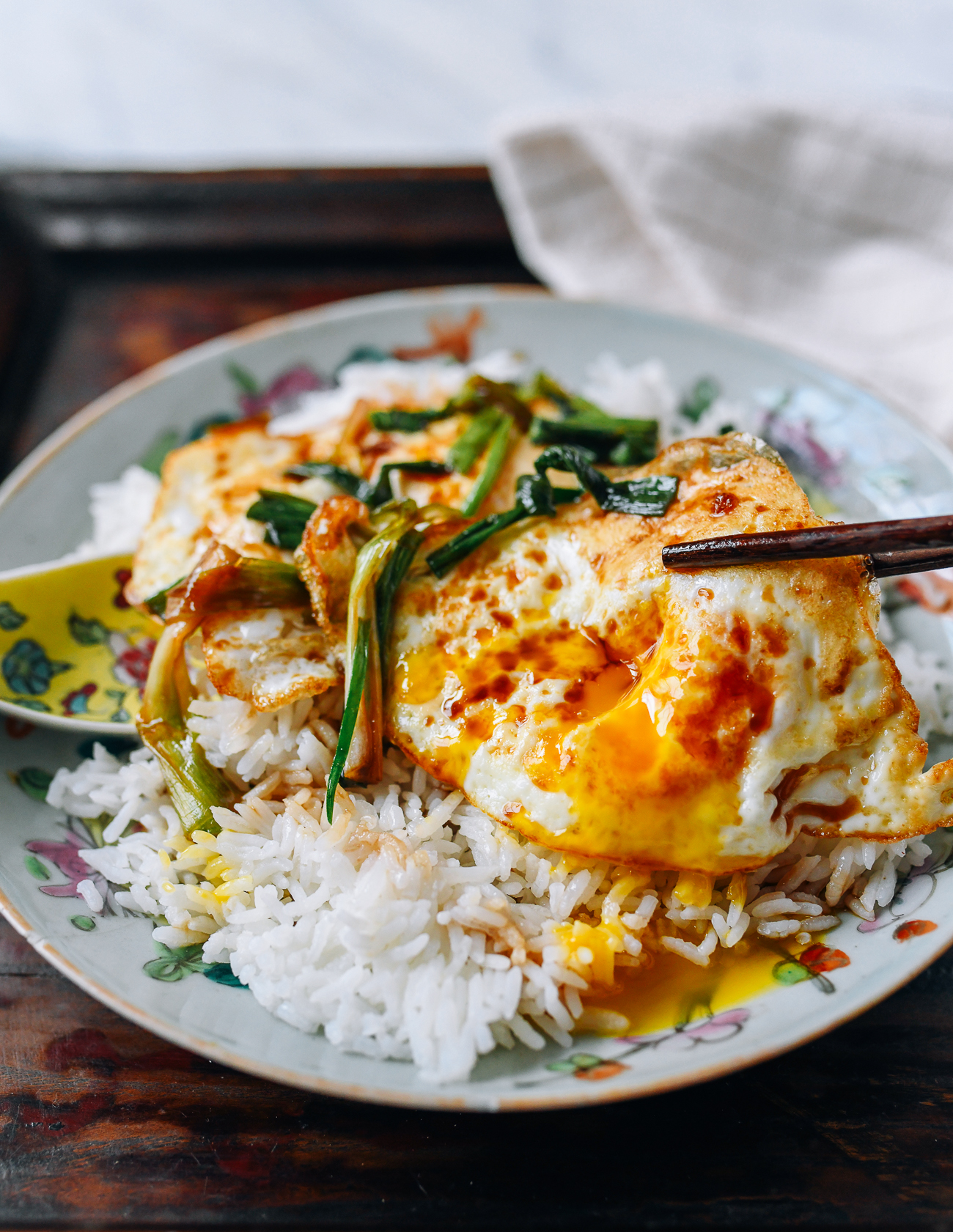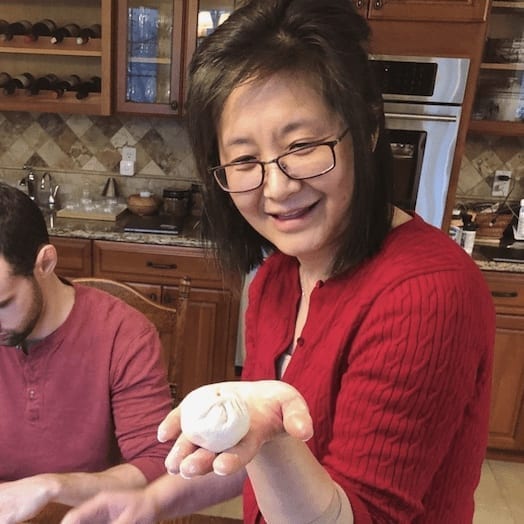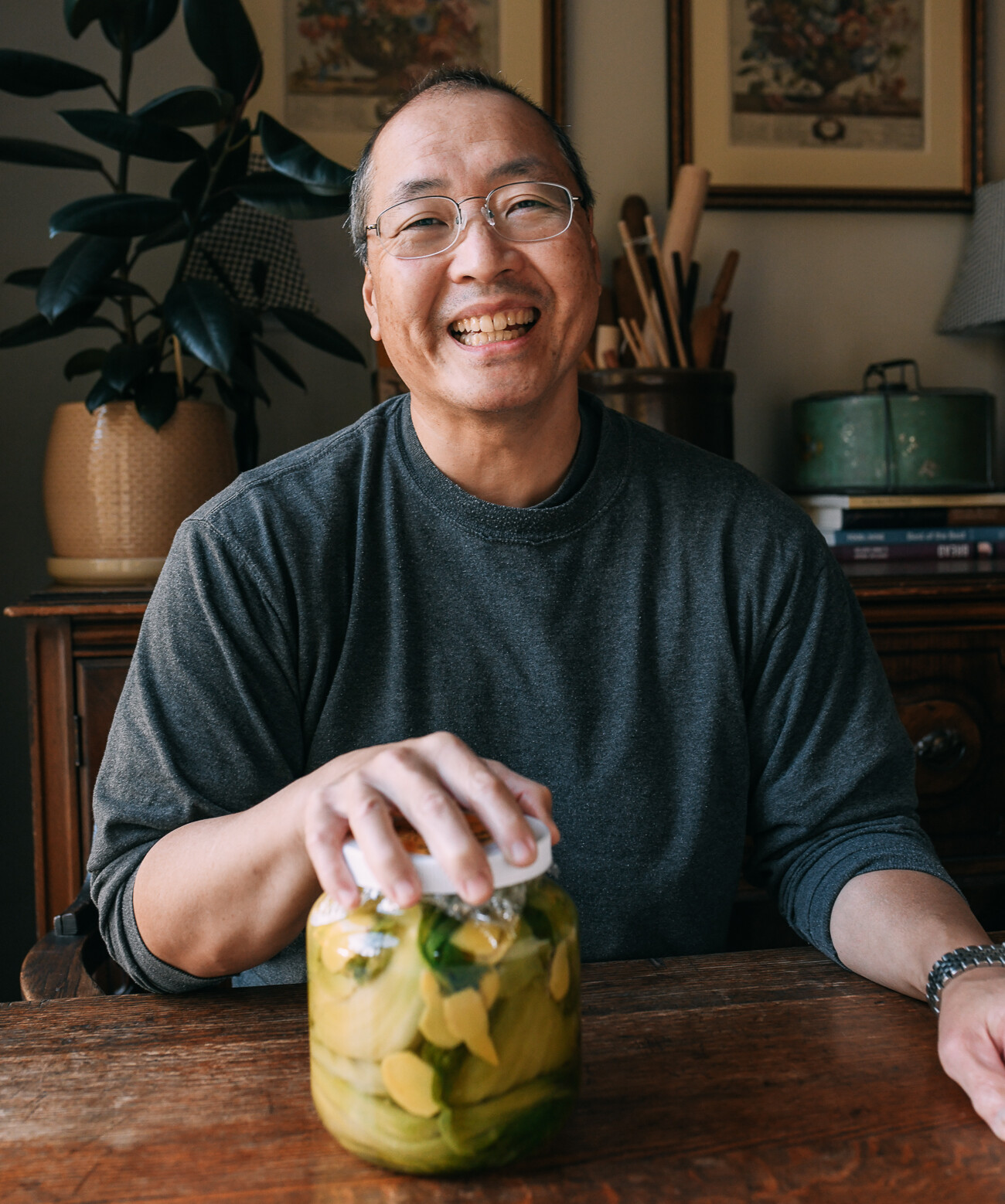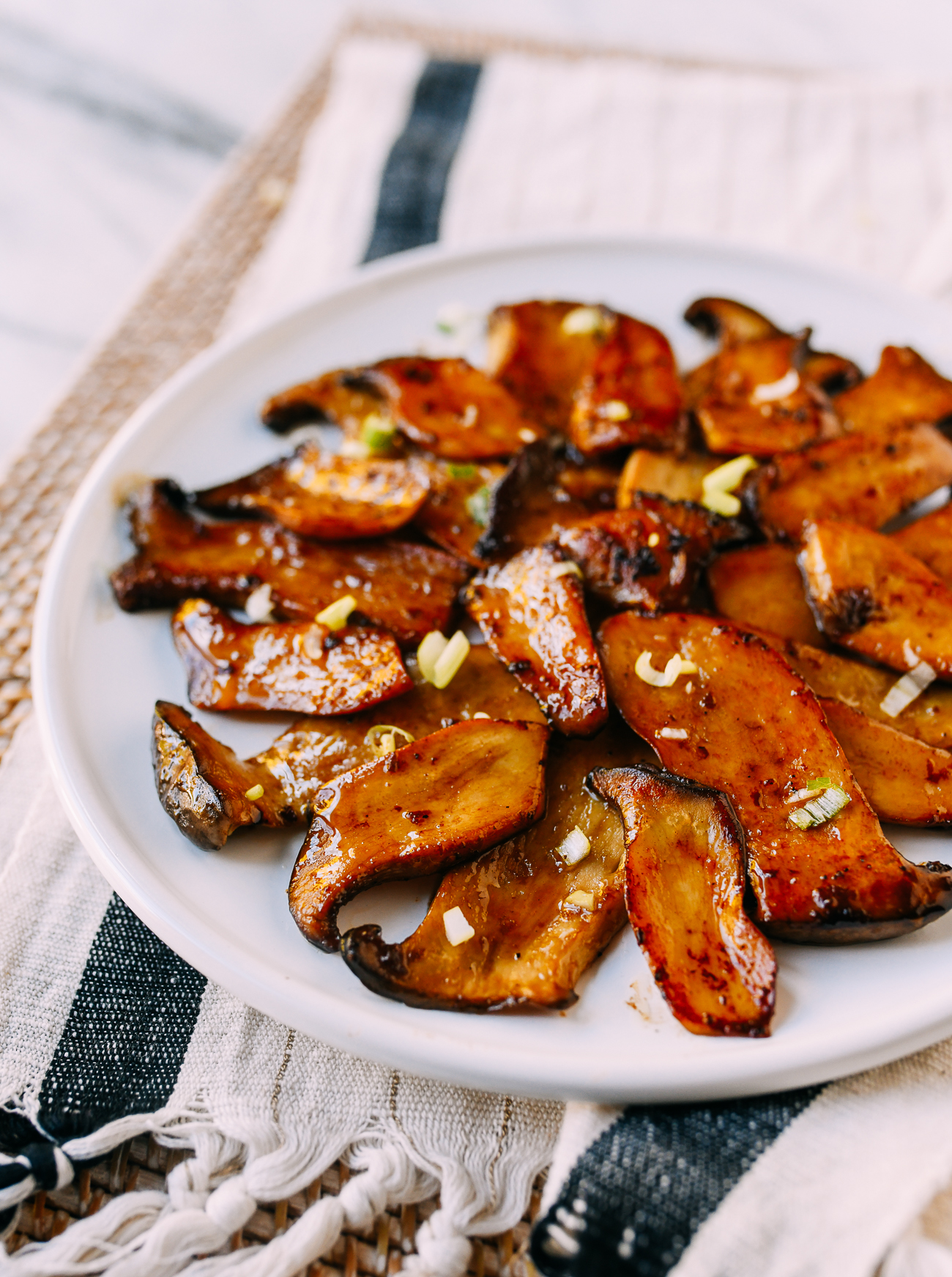
Chinese eggplant with garlic sauce is a familiar sight in many Chinese restaurants. The eggplant is super tender and seared, with a slightly sweet and tangy sauce. Served over fragrant steamed jasmine rice…this vegetable dish is just as good or better than any meat dish.
Usually, the eggplant is deep-fried to cook it quickly and preserve its purple color. Sometimes, the sauce is extremely sweet! This recipe doesn’t require deep-frying, and we think it has the perfect balance of sweetness and savoriness.
Note: We published the original version of this recipe on August 10, 2014. We have since created a new version, updated October 27, 2024. The old version is still available at the end of this post!
Is This Fish Fragrant Eggplant?
You may have heard of fish fragrant eggplant, which often gets equated with eggplant with garlic sauce. (Heck, we said as much in the original version of this recipe.)
But while the term “fish fragrant” and “garlic sauce” often get used interchangeably, we believe that these two Chinese eggplant recipes are distinct. This is eggplant with garlic sauce as it has evolved in the U.S., with Chinese chefs who were primarily of Cantonese descent.
Fish fragrant eggplant is a Sichuan dish. It involves spicy bean sauce (la doubanjiang), and while the two dishes do have similar flavor profiles, we have decided to do separate recipes for each. Look out for a Fish Fragrant Eggplant recipe soon!
What Type of Eggplant to Use
This recipe calls for Chinese or Japanese eggplant, which is longer and thinner than regular globe eggplants. These eggplants also tend to have fewer seeds (and less bitterness), thinner skins, and a more tender texture.
Chinese eggplant is a lighter purple color, while Japanese eggplants tend to be very dark purple—almost black. You can find these varieties in Asian grocery stores, and perhaps even some supermarkets in urban areas these days.
If you can’t find Chinese or Japanese eggplant, you can substitute regular globe eggplant. (Or grow your own Chinese eggplant!) Just know that it can take longer to cook, with its thicker skin and denser flesh.
If you’re finding that the eggplant isn’t getting tender in the cooking time described in the recipe (about 8 minutes), add a few tablespoons of water to the wok or pan, and cover it to steam the eggplants over medium heat. This will help them finish cooking through.

Check Out Our Cookbook
We’re sharing this recipe from our cookbook, The Woks of Life: Recipes to Know and Love from a Chinese American Family. This is an example of one of the 80 new recipes that we created and perfected for the book.
While we previously had a recipe for eggplant with garlic sauce on the blog (and it was good), it wasn’t quite the restaurant version that everyone would recognize. (If you enjoyed my dad’s old version, don’t worry—find it at the end of this post!)
Knowing that once those recipes were down on paper, we knew that we wouldn’t be able to update them like we do on the blog. That means those recipes were continually tested and re-tested—even more thoroughly than usual!
Cookbook Info
If you haven’t picked up a copy of the cookbook, you can find it in the U.S. wherever books are sold. Outside of the U.S. you can order it online from sites that ship internationally. Check out links to retailers (including ones offering signed copies!) here.
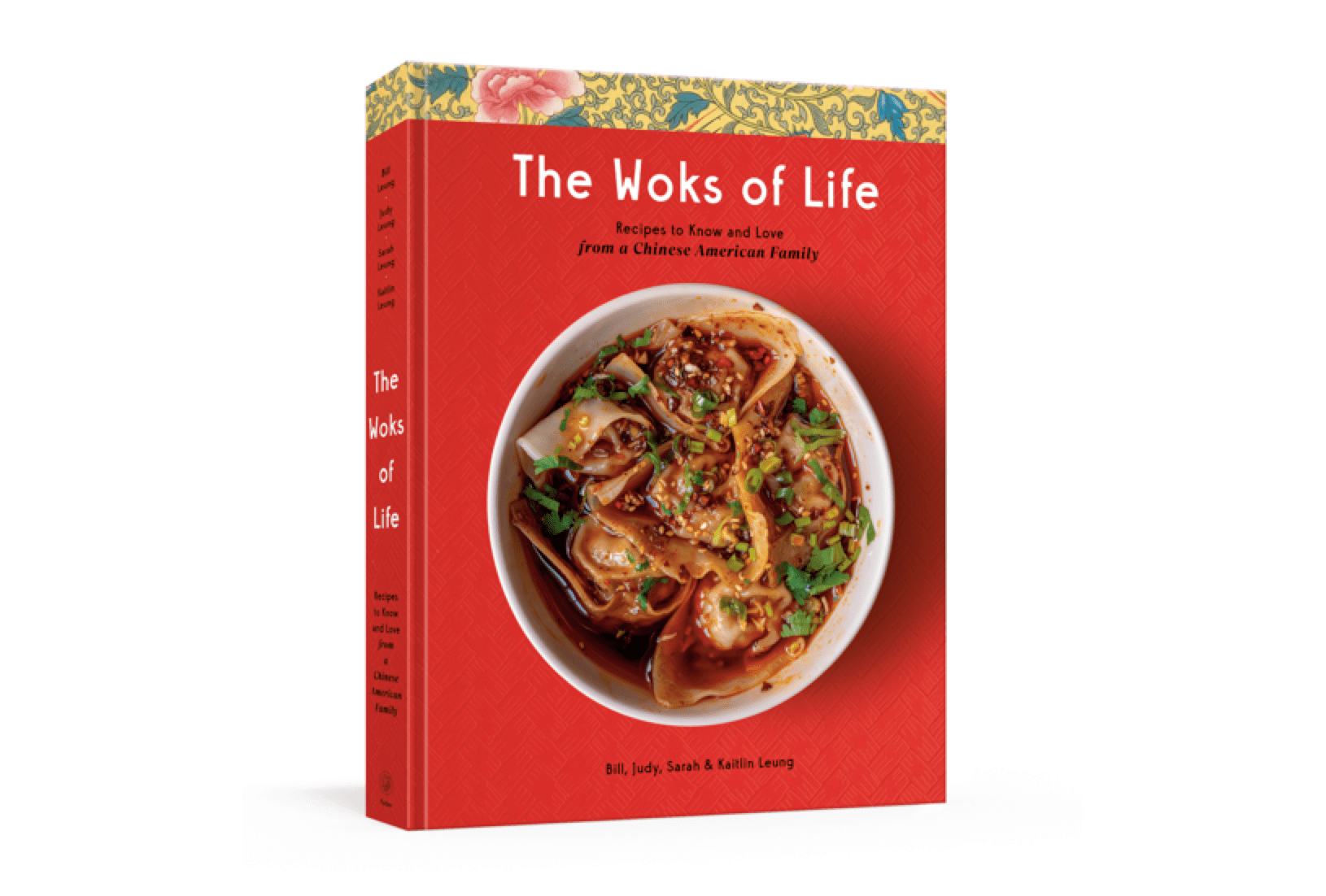
If you already have a copy, head to page 231 to see this recipe. There are so many classics in the book to try! If you’ve enjoyed it, please consider leaving a review on Amazon, Barnes and Noble, or Goodreads!
A (Perhaps Improved?) Homemade Version That Is Still Restaurant-Quality
You may be familiar with the fact that any eggplant soaks up oil like a sponge (eggplant parm, anyone?). In most cases, Chinese restaurants make eggplant with garlic sauce by deep frying the eggplant, resulting in very tasty, soft eggplant, but also a very oily dish.
There’s no doubt that deep frying makes the dish taste good, but there are definitely easier, healthier ways to go about making this dish at home that don’t sacrifice any of the restaurant flavor.
My dad’s original eggplant with garlic sauce recipe on the blog began our journey with this technique of searing the eggplant in the wok until tender and slightly scorched on the outside. It’s as simple as that. No need to salt the eggplant for an hour, no cornstarch coating. Just a simple pre-sear.
The result is restaurant-quality tender eggplant, but without all the extra oil.
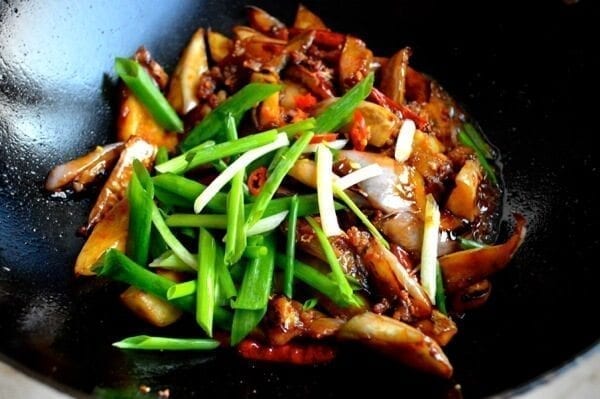
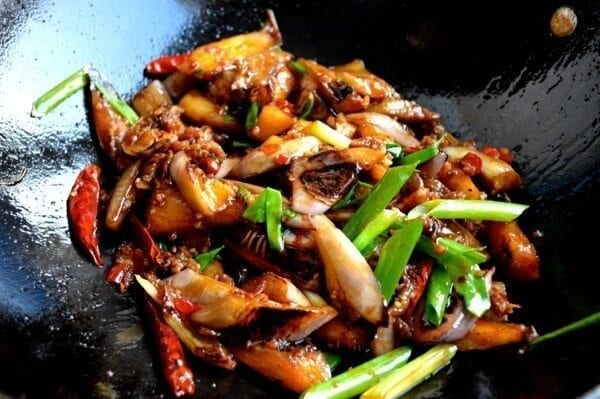
I didn’t change that technique when I developed this version of the recipe. The most significant change is the sauce. My dad’s version was a drier, less saucy dish. But most restaurant-style eggplant with garlic sauce has a LOT of sauce to spoon over your rice!

However, I often find that the dish can be too sweet. Sugar is an important ingredient, but too much can make the dish one-note. This sauce has the right balance of sweet and tangy, resulting in a much more savory dish. Like my dad’s version, a small amount (4 ounces) of ground pork adds richness to the sauce, rounding out all the flavors.
FAQs
Substitute ground dark meat chicken or turkey, or leave the meat out altogether.
This recipe calls for 2 tablespoons of minced garlic. Half gets added with the ginger, chilies, and pork in the beginning of the sauce making process, while half gets added to the sauce mixture itself, which you add later. This gives the final dish both an undertone of sweet garlic, as well as a more forward kick of garlic. The garlic sauce has more flavor and dimension! See Kaitlin’s post on cooking with garlic for more thoughts on the subject!
Absolutely! To make the dish completely vegan, simply omit the meat and substitute vegetarian oyster sauce (made with mushrooms) for the regular oyster sauce. No other changes to the recipe are necessary.
Yep. You’ll need to use a gluten-free oyster sauce (look for Lee Kum Kee’s green panda label gluten-free oyster sauce), dry cooking sherry instead of Shaoxing rice wine, a gluten-free soy sauce, and our dark soy sauce substitution, in which you mix GF soy sauce with a little sugar and molasses. Alternatively, you can just sub more regular GF soy sauce for the dark soy sauce. The dish won’t have the same dark color, but it will still be delicious! Some rice vinegars may use a small amount of wheat, so just make sure your rice vinegar is also gluten-free!
While Chinese or Japanese eggplants are really preferable, we understand that you may not have access to these ingredients. Regular eggplant will do in a pinch. You may find that the eggplant takes longer to cook until tender. If after 8 minutes of searing, the eggplant still feels firm, add a few tablespoons of water to the wok, cover, and steam over medium heat for a few minutes to cook it through.
My mom would tell you to steam the leftovers in a heatproof dish, but I say the best reheating method it is in the microwave! This dish is great leftover (store in an airtight container in the fridge for up to 4 days), but we find that leftovers are hard to come by. It all gets gobbled up!
The Best we’ve ever had
We once said that my dad’s old version of the recipe was the best we ever had. (It is still very good, and in its 10 years on the blog, garnered an average of 4.95 out of 5 stars!) Today, THIS version is the best we’ve ever had.
Every time we make it, we marvel at the perfect balance of flavors, and just how capital-T TASTY it is.
My dad’s version was published on August 10, 2014. This new version was released in our cookbook on November 1, 2022, and is making a very special blog debut on October 27, 2024.
I can’t believe how far we’ve come since we first started the blog in 2013, but I think it’s pretty safe to say we’ve learned a thing or two over the last decade of cooking and experimenting together.
Again, the old version is available right below the recipe card for the new version. Try both, and see which you like better!
Chinese Eggplant with Garlic Sauce: Recipe Instructions
In a small bowl, add the hot water and stir in the sugar to dissolve. Then add the cornstarch, oyster sauce, rice vinegar, Shaoxing wine, light soy sauce, sesame oil, dark soy sauce, and white pepper. Stir in half of the garlic (1 tablespoon), and set this mixture aside.
When you’re ready to cook, trim the ends off the eggplants and cut them on an angle, rotating the eggplant with each cut, into triangular bite-size pieces. (Don’t leave them out too long, or they will turn brown.




Heat a wok over medium-high heat until it’s smoking lightly, then pour 1½ tablespoons of the neutral oil (such as vegetable oil, canola oil, avocado oil, or peanut oil) around the perimeter of the wok to evenly coat it with oil. Spread the eggplant in a single layer, reduce the heat to medium, and cook for 3 to 4 minutes, flipping and stirring occasionally, until the eggplant is lightly browned.


Spread another 1½ tablespoons of the oil around the perimeter of the wok. Continue cooking the eggplant (still in a single layer) for another 4 minutes, stirring occasionally, until evenly seared, soft, and slightly translucent. (You may want to do this in two batches.) Remove the eggplant from the wok and set on a plate.

Preserving The Eggplant’s Color without Deep-Frying
The searing method we use in this recipe can turn the eggplant’s purple skin brown. We mentioned earlier that one of the reasons why restaurants deep-fry eggplant is not just for speed, but also to preserve its purple color. We’ve found that to maintain as much of the eggplant’s purple color as possible, the eggplant should be seared cut-sides down. This is a cosmetic issue, though, so if you’re not into fussing with it, don’t bother!
Increase the heat to high and add the remaining 1½ tablespoons oil to the wok. Add the ground pork (if using) and cook until opaque, breaking it up into small bits as you go.


Add the ginger, dried chilies, and the remaining tablespoon of garlic. Cook for 1 to 2 minutes, stirring constantly, until the aromatics are toasted and fragrant.


Add the eggplant back to the wok, and stir-fry until combined.

Stir the sauce again to ensure the cornstarch is well combined with the liquid, then add it to the wok.

Mix well and bring to a simmer, cooking until the sauce is just thick enough to coat a spoon. Stir in the scallions…


And serve immediately.

Looking for more authentic recipes? Subscribe to our email list and be sure to follow us on Pinterest, Facebook, Instagram, and Youtube!
Recipe
Chinese Eggplant with Garlic Sauce
Ingredients
- ½ cup hot water
- 1 tablespoon sugar
- 1 tablespoon cornstarch
- 1½ tablespoons oyster sauce (or vegetarian oyster sauce)
- 1 tablespoon rice vinegar
- 1 tablespoon Shaoxing wine (or dry cooking sherry)
- 1 tablespoon light soy sauce
- 1 teaspoon sesame oil
- ½ teaspoon dark soy sauce
- 1/8 teaspoon white pepper
- 2 tablespoons minced garlic (about 6 cloves garlic; divided)
- 1 pound Chinese or Japanese eggplants (2-3 eggplants)
- 4½ tablespoons neutral oil (such as vegetable oil, canola oil, avocado oil, or peanut oil)
- 4 ounces ground pork (or ground chicken, optional)
- 2 teaspoons minced ginger
- 5-10 dried red chilies (de-seeded and sliced into small pieces)
- 2 scallions (chopped)
Instructions
- In a small bowl, add the hot water and stir in the sugar to dissolve. Then add the cornstarch, oyster sauce, rice vinegar, Shaoxing wine, light soy sauce, sesame oil, dark soy sauce, and white pepper. Stir in half of the garlic (1 tablespoon), and set this mixture aside.
- When you’re ready to cook, trim the ends off the eggplants and cut them on an angle, rotating the eggplant with each cut, into triangular bite-size chunks. (Don’t leave them out too long, or they will turn brown.
- Heat a wok over medium-high heat until it’s smoking lightly, then pour 1½ tablespoons of the neutral oil around the perimeter of the wok to evenly coat it with oil. Spread the eggplant in a single layer, reduce the heat to medium, and cook for 3 to 4 minutes, flipping and stirring occasionally, until the eggplant is lightly browned. Spread another 1½ tablespoons of the oil around the perimeter of the wok. Continue cooking the eggplant (still in a single layer) for another 4 minutes, stirring occasionally, until evenly seared, soft, and slightly translucent. (You may want to do this in two batches.) Remove the eggplant from the wok and set on a plate.
- Increase the heat to high and add the remaining 1½ tablespoons oil to the wok. Add the ground pork (if using) and cook until opaque, breaking it up into small bits as you go. Add the ginger, dried chilies, and the remaining tablespoon of garlic. Cook for 1 to 2 minutes, stirring constantly, until the aromatics are toasted and fragrant.
- Add the eggplant back to the wok, and stir-fry until combined. Stir the sauce again to ensure the cornstarch is well combined with the liquid, then add it to the wok. Mix well and bring to a simmer, cooking until the sauce is just thick enough to coat a spoon. Stir in the scallions and serve immediately.
Nutrition Facts
Chinese Eggplant with garlic sauce: Our Older Version
This Chinese eggplant with garlic sauce uses a fraction of the oil in restaurant versions and is a game-changing healthier take on the dish! – Bill
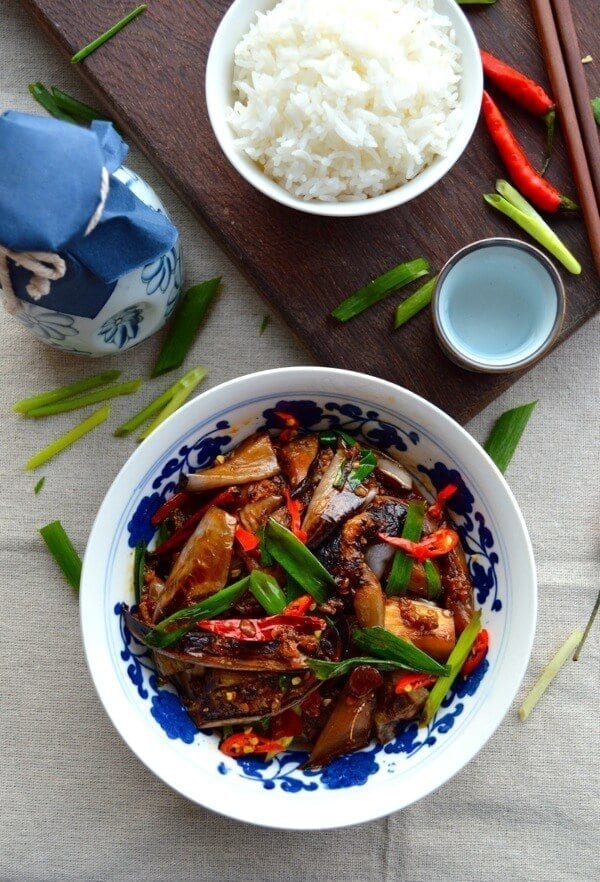
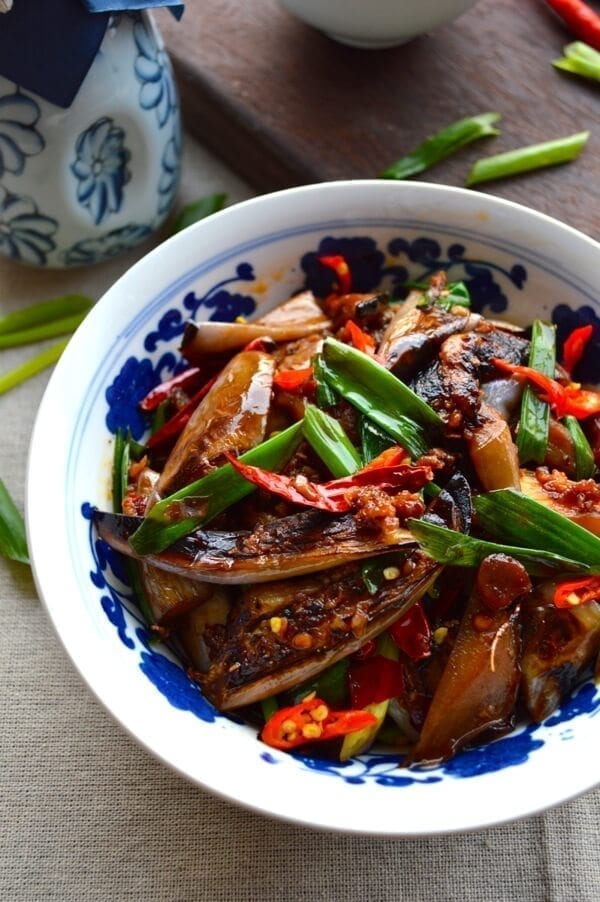
Ingredients:
For the sauce:
- 1 tablespoon spicy bean paste (la doubanjiang)
- 1 teaspoon sesame oil
- 1 tablespoon soy sauce
- 2 teaspoons sugar
- 1 tablespoon shaoxing wine or dry cooking sherry
- 1 teaspoon fish sauce
For the rest of the dish:
- 2-3 Japanese eggplants (about 1 pound or 6 cups)
- 2 scallions (cut into 2-inch lengths)
- 3 tablespoons oil
- 4 oz.//115g ground pork (or ground chicken or turkey)
- 2 thin slices ginger (julienned)
- 10 dried red chilies
- 4 cloves garlic (finely minced)
- 1 tablespoon Shaoxing wine or dry cooking sherry
Combine the sauce ingredients in a small bowl and set aside.
Wash the eggplants, cut the ends off and slice them on a sharp angle into bite-size pieces. After slicing, separate the green and white portions of the scallions into roughly two piles.
Over very high heat, heat a tablespoon of oil in your wok. Add half of the eggplant and let it sear until brown on all sides. You can lower the heat if it looks like they’re starting to burn. You want to cook the eggplant for about 5 minutes until they start to get soft and have a nice sear. Take this first batch of eggplant out of the pan, heat a second tablespoon of oil, and do the same with your second batch. Set all the cooked eggplant aside on a plate.
Set the heat to medium high and add the last tablespoon of oil to the wok, along with the ground pork. After the pork has browned, add the ginger and cook for a minute to let it crystalize with the pork. Stir in the whole red chili peppers and the minced garlic, and after a minute, turn the heat back up to high. Add the eggplant back in, along with the stir-fry sauce, the white parts of the scallions, and the wine. Stir-fry everything together for another 2 minutes, making sure everything is well-combined.
Toss in the rest of the scallions and stir-fry for another 20 seconds. Plate and serve immediately with steamed rice.





